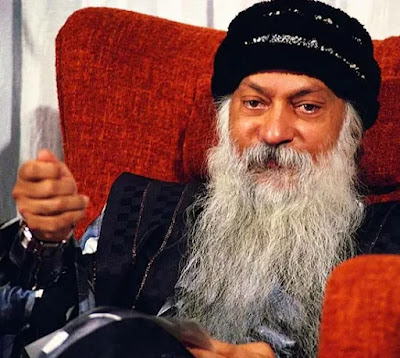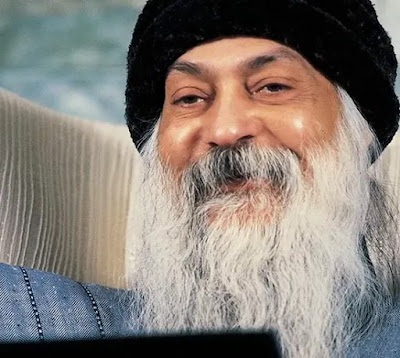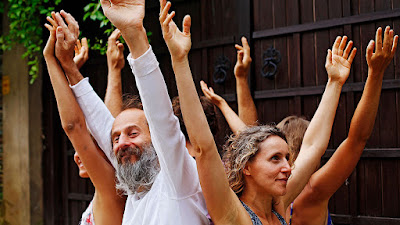Osho Biography
Uncovering the Fascinating World of Osho: A Biographical Exploration"
 |
| Osho Rajneesh |
Rajneesh, also known as Osho, was a spiritual leader and guru from India who gained a following in the 1970s and 1980s. He is known for his teachings on meditation, self-inquiry, and the importance of individual freedom and self-expression.
Osho Real Name and Early Life |
 |
| Osho Early Life |
Rajneesh was born on December 11, 1931, in Kuchwada, a small village in Madhya Pradesh, India. His given name was Chandra Mohan Jain, but he later adopted the name Osho, which means "full of bliss and peace." He received a degree in philosophy from the University of Sagar in 1955 and began teaching at various colleges and universities in India.
In the 1960s, Osho began giving lectures and conducting meditation camps, which attracted a growing number of followers. He developed his own unique brand of spirituality, which he called the "Osho International Meditation Resort," and began building ashrams (spiritual retreat centers) in India and around the world.
Osho Rajneesh Net Worth |
At
the peak of his popularity, Rajneesh was rumored to have a net worth in the
millions. However, it is difficult to accurately estimate his net worth due to
the secretive nature of his organization and the lack of transparency surrounding
his financial affairs. Rajneesh's wealth was largely derived from the donations
of his followers, many of whom were highly successful individuals. These
donations were used to fund the construction of Rajneesh's ashrams, or
spiritual retreat centers, which were located around the world. In addition to
donations, Rajneesh also earned significant income from the sale of books,
tapes, and other merchandise related to his teachings.
Despite
his wealth, Rajneesh was known for his extravagant lifestyle, which included a
fleet of luxury cars and a collection of expensive watches. He was also rumored
to have spent lavishly on personal luxuries, such as diamond-encrusted jewelry
and designer clothing.
Despite his wealth and fame, Rajneesh's reputation was marred by controversy. He was accused of manipulating and controlling his followers and was implicated in a number of illegal activities, including immigration fraud and the attempted assassination of an Oregon district attorney. However, it is clear that he was a highly influential and controversial figure who left a lasting legacy in the world of spirituality and self-improvement.
Education |
Osho, also known as Bhagwan Shree Rajneesh, was an Indian spiritual leader and guru who founded the Rajneesh movement. He was born on December 11, 1931, in Kuchwada, Madhya Pradesh, India. Osho received his early education in a local school in his hometown and then studied philosophy at D.N. Jain College in Jabalpur. He went on to earn an M.A. in philosophy from the University of Sagar and a Ph.D. in philosophy from the University of Jabalpur.
Osho was interested in the teachings of various spiritual traditions, including Hinduism, Buddhism, Taoism, and Zen, and was also influenced by the work of Friedrich Nietzsche, Søren Kierkegaard, and Carl Jung. He developed his own philosophy, which he called the "Osho Dynamic Meditation," and began teaching and leading meditation retreats in the 1960s.
Osho's Struggle |
In the 1980s, Osho faced legal and financial problems, and he and his followers were forced to leave India. They eventually settled in Oregon, where they established a commune called Osho Puram. However, their presence in Oregon was controversial, and Osho and his followers were involved in several legal battles and conflicts with local residents.
 |
| Osho Struggle |
In addition to his work in spirituality and psychology, Osho was also a prolific author, with over 600 books to his credit. His writings cover a wide range of topics, including spirituality, meditation, psychology, and social and political issues. Many of his books have been translated into multiple languages and continue to be widely read and studied today.
Overall, Osho's impact on the spiritual and philosophical world has been significant, and his ideas and teachings continue to inspire and influence people around the world. His legacy is complex, and his teachings and philosophy continue to be debated and discussed by scholars and followers alike. However, there is no denying the impact he had on the spiritual and philosophical landscape and the lasting influence of his ideas and teachings.
Osho's Ashrams |
In addition to the ashrams and communes, Osho also established a number of businesses and organizations to support his work and the needs of his followers. These included a publishing house, a healthcare clinic, and a therapy center.
Despite the controversy and legal challenges faced by Osho and his followers, the communities and organizations established by him continue to thrive and operate today. Many of these communities have evolved and adapted over time, and they continue to attract new followers and supporters from around the world.
In conclusion, Osho's influence and legacy extend far beyond his own lifetime. His ideas and teachings continue to inspire and influence people around the world, and the communities and organizations he established continue to thrive and evolve. His impact on the spiritual and philosophical landscape has been significant, and his ideas and teachings continue to be debated and discussed by scholars and followers alike.
Osho's Conflict |
Bhagwan Shree Rajneesh was involved in a number of controversies and conflicts during his lifetime. Some of the most notable ones include:
In the 1970s, Osho's teachings and practices attracted criticism from traditional Hindu leaders and the Indian government, who saw them as a threat to the country's cultural and religious values. This led to a number of legal battles and Osho was eventually forced to flee India.
- In 1981, Osho and his followers established a commune in the state of Oregon in the United States. However, they faced opposition from local residents and authorities and were involved in a number of conflicts, including a mass poisoning incident in which over 750 people were sickened
In the late 1980s, Osho faced accusations of financial wrongdoing and fraud and was eventually arrested and deported from the United States. He returned to India, where he died in 1990.
After his death, there have been ongoing disputes over the control and management of his teachings and the Rajneesh movement. Some of his former followers have accused the current leaders of the movement of corruption and mismanagement.
1
Osho's Teaching |
 |
| Osho Teachings |
One of the key aspects of Osho's teachings was the concept of "the new man." Osho's teachings focused on the importance of meditation and self-inquiry as a way to reach a state of enlightenment and inner peace. He believed that traditional religious beliefs and practices were too limiting and that individuals should be free to explore their own spiritual paths.
Osho's teachings were not without controversy, and he faced criticism from some quarters for his lavish lifestyle and the accusations of misconduct and criminal activity made against him and his followers. In addition, his teachings were seen by some as being opposed to traditional religious beliefs and practices, and he was accused of promoting a cult-like following. Despite these controversies, Osho's teachings and philosophy continue to inspire and influence people around the world. His meditation techniques and teachings on self-inquiry and personal growth are still practiced and studied by many people, and his ideas on the importance of individual freedom and self-expression continue to resonate with many people.
Osho's Legacy |
Osho's legacy is complex, and his teachings and philosophy continue to be debated and discussed by scholars and followers alike. However, there is no denying the impact he had on the spiritual and philosophical landscape and the lasting influence of his ideas and teachings.
Osho also had a strong interest in psychology and the human mind, and he developed his own unique approach to therapy and self-exploration called "dynamic meditation." This approach involved a combination of physical movement, music, and the expression of emotions as a way to access and release suppressed feelings.
Osho DYNAMIC MEDITATION |
 |
| Osho Dynamic Meditation Power |
Osho Dynamic Meditation is a powerful and transformative meditation technique developed by the spiritual leader and guru Osho. This meditation combines five elements – relaxation, breathing, catharsis, meditation, and celebration – to take the participant on a journey through the body and mind, releasing pent-up energy and emotions.
The full meditation process lasts about an hour and is typically conducted in a group setting, with music and guidance provided by a leader. It begins with a period of relaxation, during which participants lie down and listen to music, allowing their bodies to fully relax.
Next is the breathing phase, during which participants sit up and engage in rapid, forceful breathing, with the aim of releasing tension and increasing energy. This is followed by the catharsis phase, during which participants stand up and express their emotions through shouting, dancing, or other physical movements.
The fourth phase of Osho Dynamic Meditation is meditation, during which participants sit in silence and practice a form of meditation, such as mantra repetition or mindfulness. The final phase is the celebration, during which participants conclude the meditation with a period of singing or dancing.
Osho Dynamic Meditation is a unique and highly effective meditation technique that can help individuals to release negativity, increase energy and awareness, and experience a deeper sense of inner peace and joy. It is suitable for people of all ages and experience levels and can be a powerful tool for personal growth and transformation.
RAJNEESH’S “TEN COMMANDMENTS” |
- Never obey anyone’s command unless it is coming from within you also.
- There is no God other than life itself.
- Truth is within you, do not search for it elsewhere.
- Love is prayer.
- To become nothingness is the door to truth. Nothingness itself is the means, the goal, and the attainment.
- Life is now and here.
- Live wakefully.
- Do not swim—float.
- Die each moment so that you can be new each moment.
- Do not search. That which is is. Stop and see.
Osho's Death |
Osho, also known as
Bhagwan Shree Rajneesh, was a spiritual leader and guru who inspired millions
of people around the world with his teachings and philosophy. On January 19,
1990, Osho passed away at the age of 58, leaving a lasting legacy that
continues to influence people today.
In the final months of
his life, Osho was suffering from various health problems, including diabetes
and heart disease. Despite his illness, he continued to teach and lead
meditation retreats at his ashram in Pune, India, where he had lived and worked
for many years.
On the day of his death,
Osho collapsed while giving a discourse at the ashram and was rushed to a
hospital, where he was pronounced dead. The cause of his death was listed as
heart failure. Osho's passing was mourned by his followers around the world,
who had been inspired by his teachings on mindfulness, self-awareness, and
personal growth. His ashram in Pune has since become a popular destination for
spiritual seekers, and his teachings and philosophy continue to be studied and
practiced by people all over the world.
Osho's last days were a
time of reflection and contemplation for his followers, as they paid tribute to
a man who had touched their lives in profound ways. His message of love,
compassion, and understanding will continue to inspire and guide people for
generations to come.
Conclusion |
In conclusion, Osho's approach to spirituality and self-inquiry was strongly influenced by his own experiences and personal journey. His ideas and teachings continue to inspire and influence people around the world, and the communities and organizations he established continue to thrive and evolve. His impact on the spiritual and philosophical landscape has been significant, and his ideas and teachings continue to be studied and debated by scholars and followers alike.








Post a Comment
0 Comments
Please do not entery any spam link in the comment box!